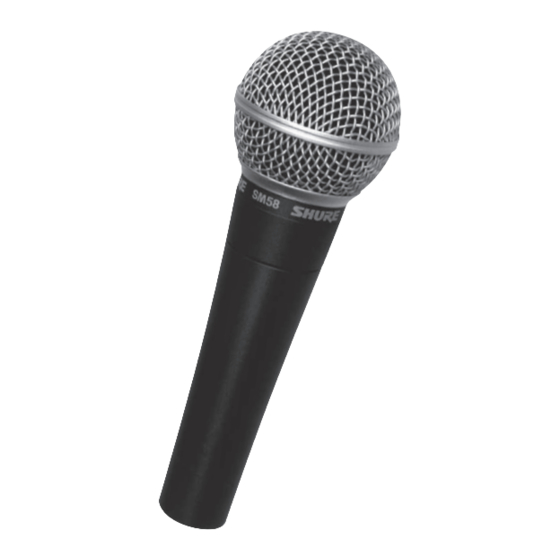
Shure SM58 Mode D'emploi
Masquer les pouces
Voir aussi pour SM58:
- Mode d'emploi (21 pages) ,
- Manuel d'instructions (2 pages) ,
- Mode d'emploi (16 pages)
Table des Matières
Publicité
Les langues disponibles
Les langues disponibles
Liens rapides
GENERAL
®
The Shure SM58
is a unidirectional (cardioid) dynamic vocal
microphone for professonal vocal use in sound reinforcement and
studio recording. A highly effective, built-in, spherical filter minimiz-
es wind and breath "pop" noise. A cardioid pickup pattern isolates
the main sound source while minimizing unwanted background
noise. The SM58 has a tailored vocal response for a sound which
is a world standard. Rugged construction, a proven shock mount
system, and a steel mesh grille ensure that even with rough han-
dling, the SM58 will perform consistently. Outdoors or indoors,
singing or speech, the SM58 is the overwhelming choice of profes-
sionals worldwide.
Features
• Frequency response tailored for vocals, with brightened
midrange and bass rolloff
• Uniform cardioid pickup pattern isolates the main sound source
and minimizes background noise
• Pneumatic shock-mount system cuts down handling noise
• Effective, built-in spherical wind and pop filter
• Supplied with break-resistant stand adapter which rotates 180°
• Legendary Shure quality, ruggedness, and reliability
Variations
SM58
SM58S (With On/Off Switch)
PROXIMITY EFFECT
When the sound source is less than 6 mm (
microphone, the microphone boosts bass frequencies (by 6 to 10
dB at 100 Hz), creating a warmer and richer bass sound than when
farther away. This effect, known as proximity effect, happens only
in unidirectional microphones like the SM58. The SM58
low-frequency roll-off provides greater control, allowing the user to
take full advantage of proximity effect.
APPLICATIONS AND PLACEMENT
The SM58 is ideal for close-up vocals and can be held in the
hand or mounted on a stand. Some of the most common
applications and placement techniques are listed in the following
table. Keep in mind that microphone technique is largely a matter
of personal taste—there is no one "correct" microphone position.
2006, Shure Incorporated
©
27B2902 (Rev. 3)
APPLICATION
Lead &
Backup
Vocals
Speech
STAGE MONITOR & P.A. LOUDSPEAKER
PLACEMENT
Place the stage monitor directly behind the microphone (see
Figure 1). Locate the P.A. loudspeakers so that they point away
from the rear of the microphone. With the speakers located in
these positions, the possibility of feedback is greatly reduced. Al-
ways check the stage setup before a performance to ensure opti-
mum placement of microphone and monitors
.
LOUDSPEAKERS
GENERAL RULES FOR MICROPHONE USE
1. Aim the microphone toward the desired sound source and
away from unwanted sources.
2. Locate the microphone as close as practical to the desired
1
/
in.) from the
sound source.
4
3. Work close to the microphone for extra bass response.
4. Use only one microphone per sound source.
5. Locate microphones at least three times as far from other
microphones as from the sound source.
6. Use as few microphones as practical.
7. Place microphones far from sound-reflecting surfaces.
8. Add a windscreen when using the microphone outdoors, for
closeup speech, or vocals.
9. Avoid excessive handling to minimize mechanical noise.
Model SM58
SUGGESTED MICROPHONE
PLACEMENT
Lips less than 150 mm (6 in.)
away or touching the
windscreen, on axis to
microphone.
150 mm (6 in.) to .6 m (2 ft) away
from mouth, just above nose
height.
200 mm (8 in.) to .6 m (2 ft) away
from mouth, slightly off to one
side.
1 m (3 ft) to 2 m (6 ft) away.
STAGE
MONITOR
P.A.
MICROPHONE
RECOMMENDED LOUDSPEAKER PLACEMENT
FIGURE 1
®
User Guide
TONE QUALITY
Robust sound,
emphasized bass,
maximum isolation
from other sources.
Natural sound,
reduced bass.
Natural sound,
reduced bass and
minimal "s" sounds.
Thinner; distant
sound;
ambience.
SOUND
SOURCE
Printed in U.S.A.
Publicité
Table des Matières

Sommaire des Matières pour Shure SM58
-
Page 3: Règles Générales D'utilisation De Microphones
Que ce soit pour la salle ou le plein air, le chant ou la parole, le SM58 est le choix de prédilection des DISPOSITION DES RETOURS DE SCÈNE ET DES professionnels des quatre coins du globe. -
Page 4: Caractéristiques
Pour des informations plus détaillées sur les réparations ou les sitive sur la broche 2 par rapport à la broche 3 pièces de rechange, contacter le service après-vente de Shure, au Connexions internes (voir la figure 4) 1-800-516-2525. Hors des États-Unis contacter le centre de réparations agréé...











